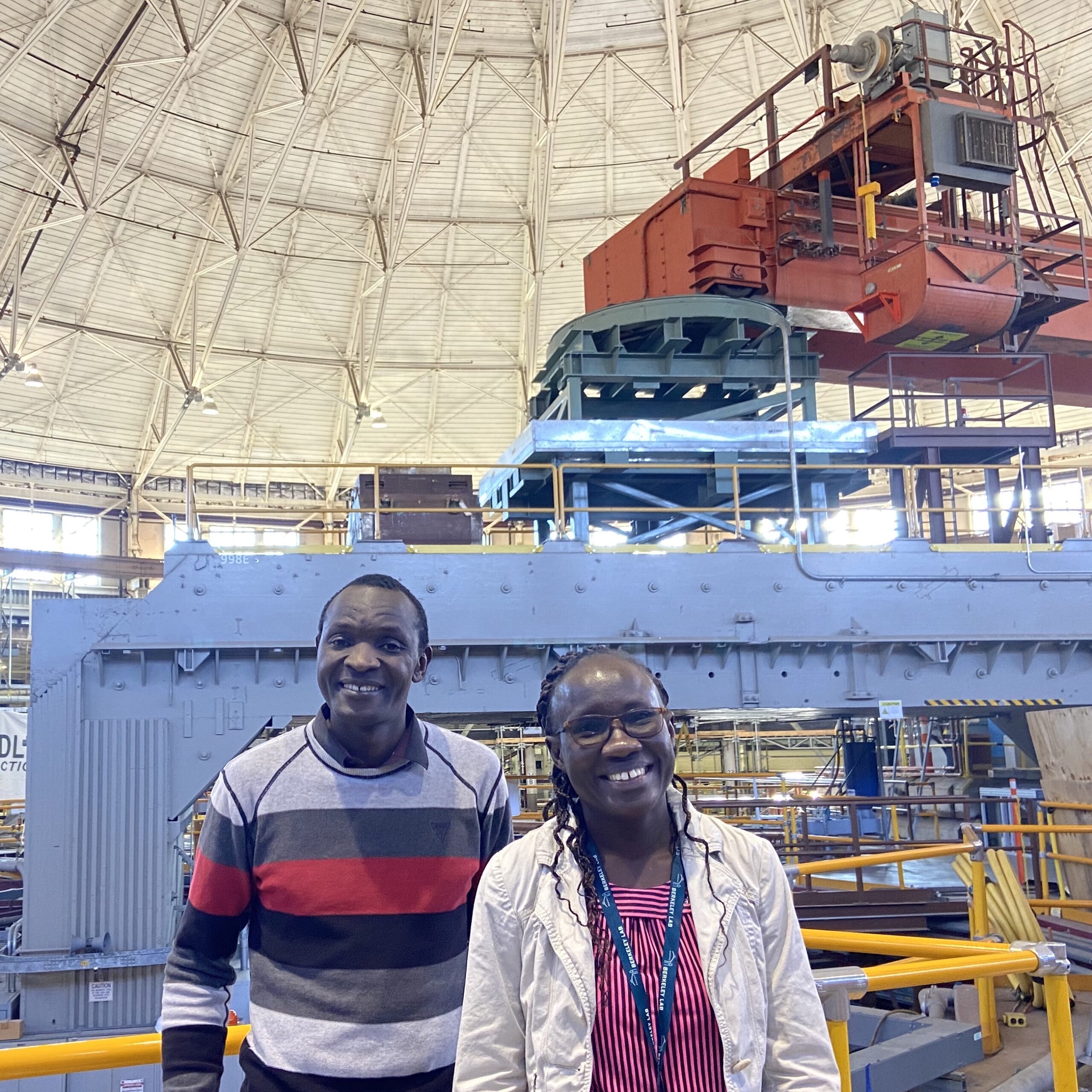
This is a story of miles and nanometers. Celline Awino Omondi and Miller Shatsala traveled from Kakamega, Kenya, to Berkeley, USA, through a grant from Lightsources for Africa, the Americas, Asia, Middle East, and Pacific (LAAAMP), a journey of over 9,400 miles. Their research interests, however, are best described with nanometers—very thin perovskite films to be used for solar energy.
At their home institution, Masinde Muliro University of Science and Technology, Omondi is a faculty member and Shatsala is a PhD student in the department of physics. Omondi’s interest in new materials began in graduate school. “I did a master’s in materials nanotechnology, and it was so interesting, I wanted to continue in materials science,” she said. Though her doctoral studies were in Germany, her research inspiration was closer to home. “In Africa, we have abundant solar radiation. So, we are looking for a way to tap into that solar radiation so that we can use it for our daily life.”
Omondi envisions many applications for photovoltaics. With the new materials under development, solar energy could be used in the future for everything from household electricity to vaccine storage in hospitals and irrigation on farms. New materials to harness solar energy would be life changing. “Most parts of Africa aren’t on the grid, and if they have electricity, it’s very expensive,” Omondi explained.
Similarly, Shatsala’s master’s thesis research focused on silicon solar cells. “Then I discovered that there are new materials coming up in solar energy whose efficiency was almost passing silicon, so that’s why I shifted to perovskites,” he said.
To characterize the perovskites they’re studying, the two researchers came to the Advanced Light Source through a LAAAMP Faculty-Student (FAST) Teams grant. The program provides financial support for PhD students and their faculty advisors from Africa, the Caribbean, Mexico, Central Asia, Southeast Asia, the Middle East, and Pacific to spend two months in residence at a collaborative partner light source. With this training opportunity, scientists like Omondi and Shatsala will be able to take their newfound skills and knowledge back to a region that is still in the planning phases for its own synchrotron facility. One day in the future, the two researchers could be part of operating and using this facility—the African Light Source. “We were privileged to be picked to be among the few people in Africa to come to the ALS,” said Shatsala.
He and Omondi first connected with ALS Deputy for Strategy Ashley White, who introduced them to Staff Scientist Chenhui Zhu to serve as their ALS host. “Chenhui has taken us through his beamline, which is for small and wide-angle x-ray scattering,” Omondi said. “We’ve seen how samples are being placed, and we’ve seen in situ measurements with the spin coater at the beamline.”
The setup at Beamline 7.3.3 is well suited to characterize perovskite samples, silicon wafers coated with 100–200 nm thin films. But, getting to the point of characterization has been the opposite of straightforward for these researchers. To gather the resources for preparing samples in the first place, Omondi and Shatsala tirelessly submitted grant applications around the world. Only after they received funding could they order reagents and equipment, which then took months to arrive in Kenya from far flung locales like Germany and Italy.
Unfortunately, the distance and time separating each step of the process took a toll on the sample preparation. They worked with Aidan Coffey, an ALS postdoctoral fellow who is well versed in perovskites, to take initial measurements. “Aidan was very supportive,” Omondi said, “but the results were not good.” The samples they brought from Africa had degraded.
The relative instability of perovskites has hindered efforts to commercialize these materials for solar energy. “The problem we encountered is the problem we are trying to solve,” said Shatsala. “In situ measurements at the beamline show us how the perovskites crystallize under heat and humidity,” he explained, adding, “If we learn about the crystallization of the materials, then we can easily know how to make them stable.”
But, they still needed to have intact samples to characterize. Zhu introduced Omondi and Shatsala to researchers at Berkeley Lab’s nanoscience user facility, the Molecular Foundry. They worked with Carolin Sutter-Fella and Tim Kodalle to prepare new samples. After mixing powders into solution and applying them to silicon wafers, they were ready to take measurements at multiple ALS beamlines.
At Beamline 7.3.3, the researchers used the spin coater to distribute precusor-containing solution across the wafer, which then dried into a thin film. Throughout the spin-coating process, they took measurements using grazing-incidence wide-angle x-ray scattering to gain insights into the structure and crystallization mechanism of the sample. Zhu also connected them with Senior Scientist Nobu Tamura, whose beamline has microdiffraction capabilities, and Photon Science Operations Group Lead Mike Martin, who has been a longtime supporter of the African Light Source.
“Before we came, we thought the research here was just physics, chemistry, and biology,” Shatsala recalled, “but we have learned that a lot more can be done.” Beyond the up-close experience at ALS beamlines and Molecular Foundry facilities, Omondi and Shatsala expressed their appreciation for the people they have met at Berkeley Lab and the collaborations that are possible in the future. “Now, we are ambassadors for the ALS,” Shatsala promised.
With their LAAAMP-funded experience, Shatsala and Omondi will not only be able to use the African Light Source in the future, they will also be able to train other researchers and further build the network of synchrotron science. “I wish the fellowship could be extended to six months or a year,” Omondi said. With all that she has learned already, she knows that she could accomplish even more with a longer stint at the ALS. Perovskites for photovoltaics, solar energy for Africa, and construction of the African Light Source—they are all ambitious and audacious. They, too, will be stories of miles and nanometers.
